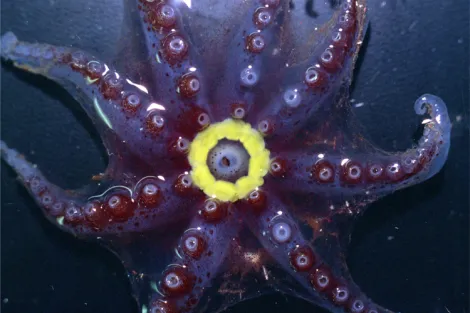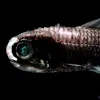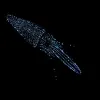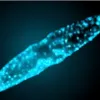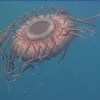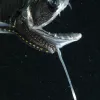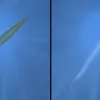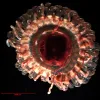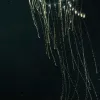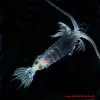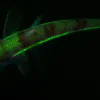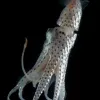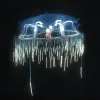The yellow bioluminescent ring on this female octopus (Bolitaena pygmaea) may attract mates. Bioluminescence is an important adaptation that helps many deep sea animals survive in their dark world. More about deep ocean exploration can be found in our Deep Ocean Exploration section.
Bioluminescent Animals Photo Gallery
Bioluminescence is one of the more captivating adaptations that have evolved in marine animals. It's the ability of organisms to create and emit light. Dive underwater and you may witness lightshows of red, green, and blue. Chemical reactions release energy that produces the light. Many species use it to communicate; some use it to lure their next meal; and others emit light to ward off predators. According to NOAA, scientists estimate that bioluminescence exists in 90 percent of the animals living in the open ocean, in waters below 500 m (1,640 ft). It's a trait that has evolved in a variety of organisms—a small fraction of which are in this slideshow.
Bioluminescence has inspired scientists and artists alike. Watch a video of researchers sharing stories of their encounters with bioluminescent animal, learn about the luminous art of Shih Chieh Huang, and find out more about bioluminescence.

Bioluminescent Octopod
Credit: Michael Vecchione/NOAA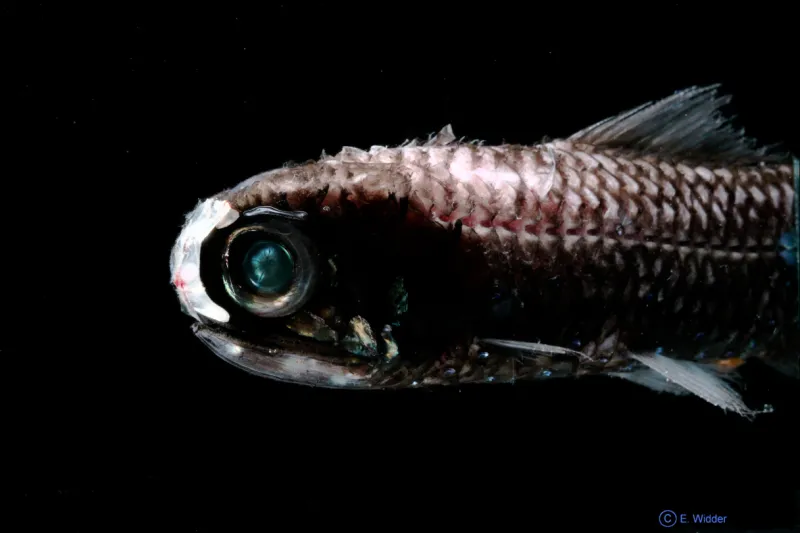
Lanternfish
Credit: E. Widder, ORCA, www.teamorca.orgThis lanternfish (Diaphus sp.), found in the Red Sea, has light-producing photophores along its ventral surface (belly), and a nasal light organ that acts like a headlight. Hear scientists tell stories about encountering bioluminescent marine animals in the deep sea.
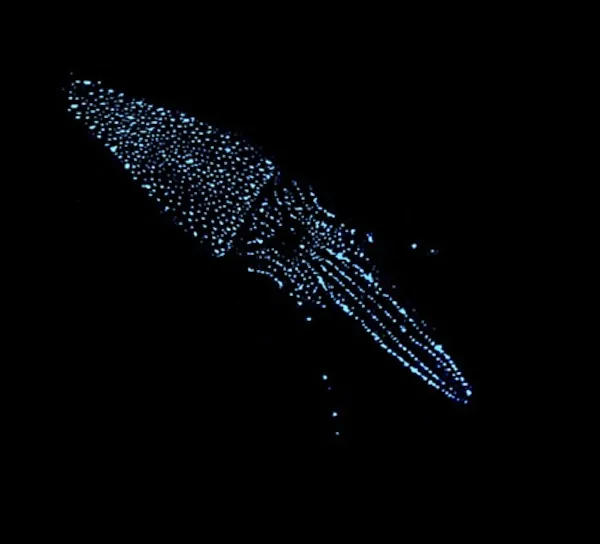
Midwater Squid, Abralia veranyi
Credit: E. Widder, ORCA, www.teamorca.orgGlowing photophores are visible on this midwater squid (Abralia veranyi) viewed from below at low light levels. We think of light as a way to see in the dark. But many species use it to help them hide. This adaptation is called counterillumination. Seen from below, an animal might stand out as a dark shape against the brighter water above. By glowing on its underside, it can blend in. Watch a video of scientists describing their encounters with bioluminescent animals in the deep sea.
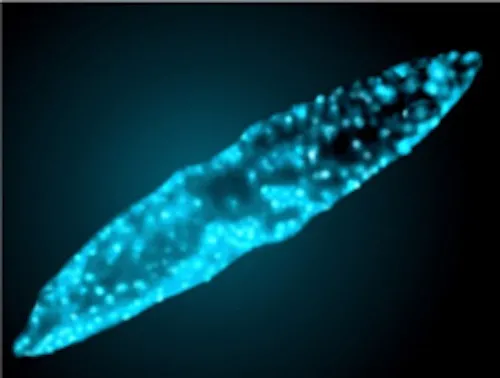
Bioluminescing Dinoflagellate
Credit: E. Widder, ORCA, www.teamorca.orgSunset? Time to glow! A biological clock triggers bioluminescence in the dinoflagellate Pyrocystis fusiformis. At dusk, cells produce the chemicals responsible for its light. Hear from marine scientists about what it's like to encounter bioluminescent animals in the deep sea.
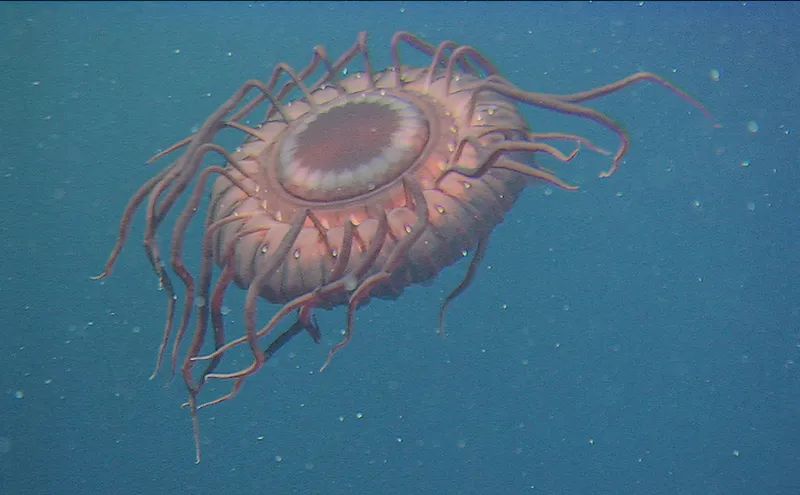
Atolla Jellyfish from the Waters of Japan
Credit: JAMSTECThe ROV Hyper Dolphin caught this deep-sea jelly (Atolla wyvillei) on film east of Izu-Oshina Island, Japan. When attacked, it uses bioluminescence to "scream" for help—an amazing light show known as a burglar alarm display. Visit the Encyclopedia of Life to learn more about these wild jellies.

Scaly Dragonfish
Credit: © David ShaleThe long barbel on the chin of this dragonfish (Stomias boa) has a glowing tip that may attract prey. With its large mouth and sharp, curved teeth, the fish makes quick work of any prey that venture too close. Scaly dragonfish live at depths of 200-1,500 meters (656-4,921 feet) and grow up to 32 centimeters (12.6 inches) long. More about deep ocean can be found in the Deep Ocean Exploration section.
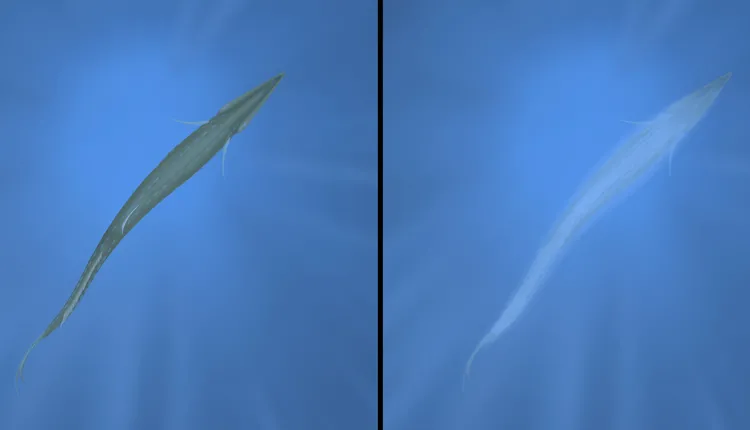
Fish Using Counterillumination
Credit: Smithsonian InstitutionThe fish at left stands out against the lighter waters above. At right the same fish—now with bioluminescent structures on its underside lit—blends in. Many deep sea creatures have evolved this adaptation (known as counterillumination), which enables them to hide in an environment with few hiding places. More about deep ocean exploration can be found in the Deep Sea section.
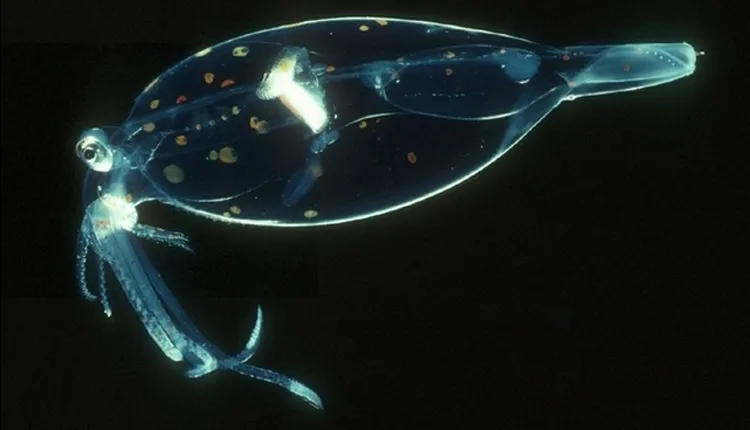
Cockatoo Squid
Credit: Marsh Youngbluth/MAR-ECO, Census of Marine LifeThis transparent cockatoo squid (Leachia sp.), also known as a glass squid, lives in the depths of the ocean and has many adaptations to help it survive there. It retains ammonia solutions inside its body that give it a balloon-like shape and help it float. It has large eyes and pigment-filled cells, or chromatophores, that look like polka dots and serve as camouflage.
See more pictures of bioluminescent animals that light up in the dark ocean water, and other organisms found in the deep ocean by the Census of Marine Life.
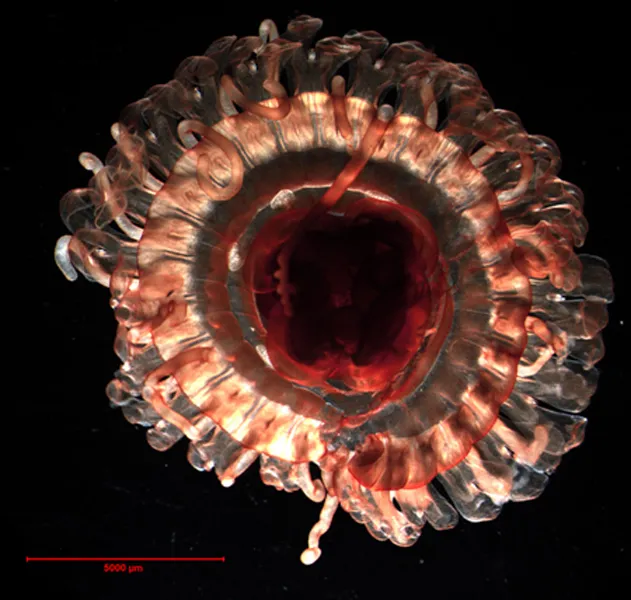
Midwater Sea Jelly
Credit: R. Hopcroft, UAF.Atolla tenella, a midwater scyphomedusa, as seen under a microscope. View the “Under Arctic Ice” photo essay to learn more.
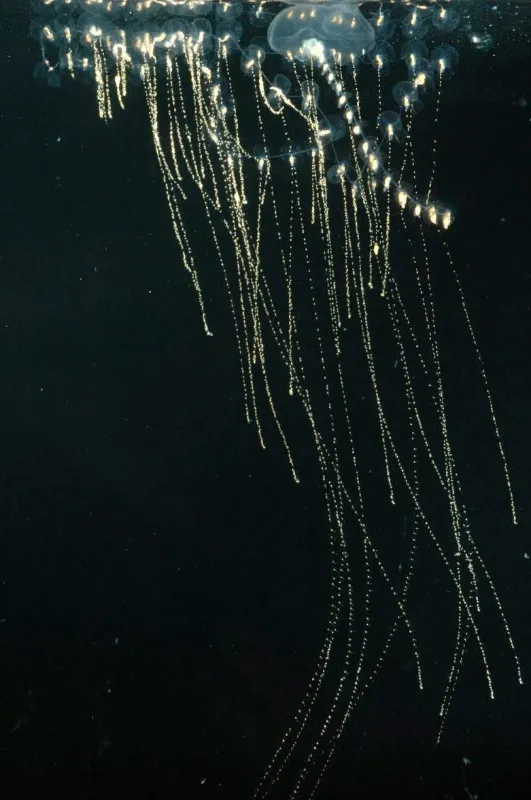
Jellyfish, or Siphonophore Colony?
Credit: L. Madin, Woods Hole Oceanographic Institution (www.cmarz.org)This colony of Rosacea may look like a single jellyfish, but it is actually a large group of smaller siphonophores clustered and living together. In fact, the zooids (individual siphonophores living in the colony) cannot survive on their own. This specimen was photographed by the Census of Marine Zooplankton, a project of the Census of Marine Life, in the Sargasso Sea in April 2006.
A Rosacea colony's long tentacles extend a meter away from the main body and contract when disturbed by potential food items. The bead-like dots are stinging cells (nematocysts) that immobilize and kill their prey.
See more photos of cool zooplankton collected by the researchers in this zooplankton biodiversity slideshow, and learn more about jellyfish, comb jellies and other gelatinous ocean animals.
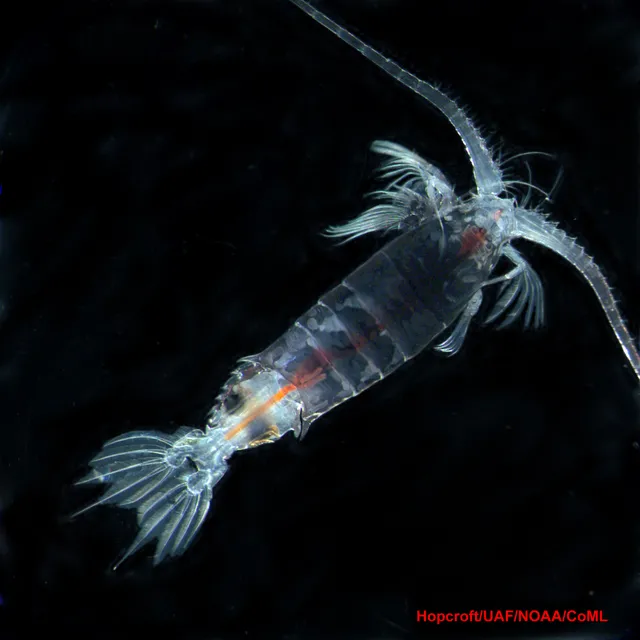
Deep Sea Copepod
Credit: R. Hopcroft, University of Alaska - Fairbanks (www.cmarz.org)This copepod (Gaussia princeps) was collected deeper than 1000 meters in the Sargasso Sea by Census of Marine Zooplankton (CMarZ) researchers in April 2006, as part of the 10-year Census of Marine Life. However, specimens of this species have been collected in all the world's oceans at many depths: in the Caribbean, it has been found at depths as shallow as 25-50 meters!
G. princeps is a bioluminescent species, with both males and females producing blue light. Its light is bright enough that molecular biologists use the bioluminescent pigment as dye in the lab to help them visualize their experiments.
Reference: Suarez-Moralez, E. 2007. The mesopelagic copepod Gaussia princeps (Scott) (Calanoida: Metridinidae) from the Western Caribbean with notes on integumental pore patterns. Zootaxa 1621: 33–44. (PDF)
See more photos of cool zooplankton collected by the researchers in this zooplankton biodiversity slideshow.
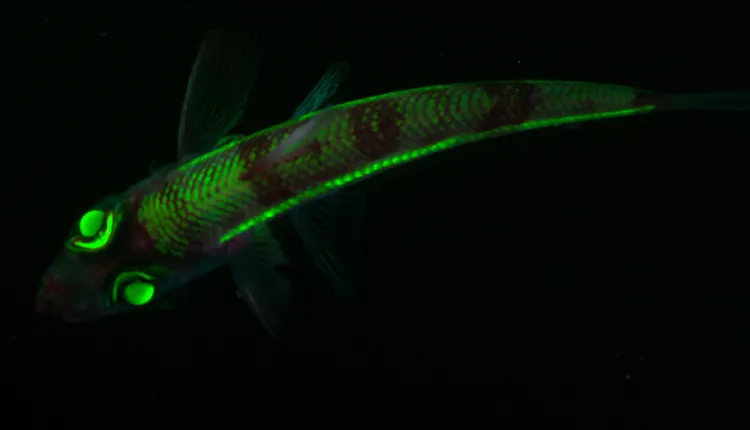
A Shortnose Greeneye Fish Aglow
Credit: Image Courtesy Edie WidderUnder white light, this shortnose greeneye fish (Chlorophthalmus agassizi) looks unimpressive. But, in dim blue light—the type usually seen at depth—it shows its true fluorescent colors.
NOAA scientists collected this specimen during a 2004 expedition for optical studies. The scientists believe the green flourescence of the fish’s eye lenses help it detect prey better in dimly lit water.
Bioluminescent creatures emit and produce their own light, whereas fluorescence is the emission of light by a substance—not always living—that has absorbed light or other radiation of a different wavelength. Animals use bioluminescence for many reasons including communication, but fluorescent creatures depend on the light to determine when they "glow."
According to the scientists who were part of NOAA's 2004 expedition, the shortnose greeneye fish's lens absorbs light that comes from the surface of the ocean, but it lets through the turquoise-colored light of most bioluminescence creatures. This allows the fish to discern the color of its prey in deep ocean waters.

Jewel Squid
Credit: David Shale/MAR-ECO, Census of Marine LifeThis beautiful jewel squid (Histioteuthis bonnellii) can be found swimming above the Mid-Atlantic Ridge, at depths of 500-2,000 meters (1,640-6,562 feet). The “jewels” covering the body are bioluminescent photophores. But these squids can't bargain for their lives with those jewels: they have been found in the stomachs of sperm whales, swordfish and sharks.
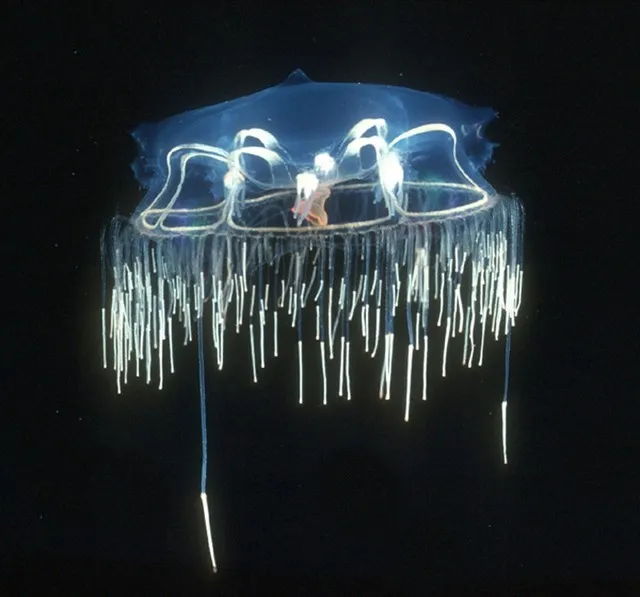
Midwater Jellyfish
Credit: Marsh Youngbluth/MAR-ECO, Census of Marine LifeA fringe of short tentacles surrounds the flattened bell of this tiny, transparent jellyfish (Halicreas minimum), which can be found at depths up to 984 feet (300 meters). But it would be hard to spot: the bell grows up to just 4 centimeters (2 inches) across! See more deep ocean diversity and explore more about jellyfish biodiversity.


